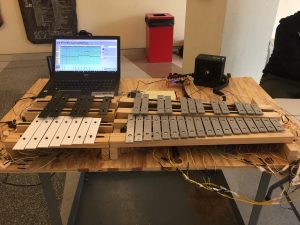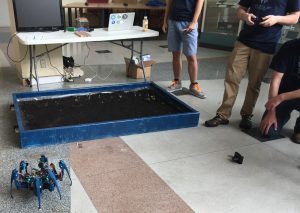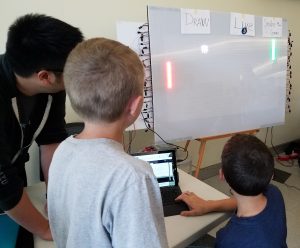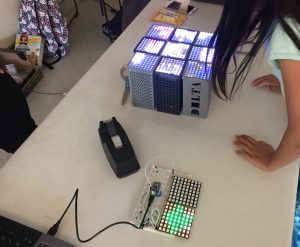Undergraduate
Electronic Design Project (EEC 136AB)
A team-based senior capstone design project class, the Electronic Design Project course engages teams of 3-4 students in specifying and designing an electronic product for a consumer, medical, or industrial application. Student designs are based around microcontrollers and teams integrate sensors, actuators, analog integrated circuits, power electronics, and a wireless interface to accomplish specific tasks like safety lighting for a bicycle. Recent projects also include interfacing the design to smartphones and creating apps that support a graphical user interface.
Next Offering: Fall 2019/Winter 2020
Past Offerings: Fall 2018/Winter 2019, Fall 2017/Winter 2018, Fall 2016/Winter 2017
EE-Emerge (EEC 198)
A team-based junior design project course, EE-Emerge supports teams of 8-10 students to design, implement, and showcase interactive electronic exhibits for Picnic Day, UC Davis’ annual open house. Teams design the exhibits to engage the general public, especially children, to increase excitement about science and technology.

Combining traditional instruments with electronics creates new ways of making music. The voice-activated electronic glockenspiel developed for Picnic Day 2017 uses electromechanical relays to strike the keys that generate the musical tones. The team designed the driver circuits for the relays and controlled them through MIDI interface software running on a laptop. The voice-activation software also ran on the laptop. A brief video of the glockenspiel in action is here.

Feeding a hungry planet with less inputs of water, fertilizer, and manual labor is an important challenge for society. Robots can help support planting, growing, and harvesting of crops. The Gardroid project created an open-source design for a six-legged robot that can be directed using a video game controller to plant seeds.

Advances in solid-state lighting continue to decrease the cost of light-emitting diodes (LEDs), to the point where it is now possible to create large displays using LED strips at low cost such as the LED Mirror. Using a microcontroller to program the LEDs and interfacing to a laptop with a built-in camera, the LED Mirror can operate as a drawing tablet, video game machine, and computer monitor, in addition to acting like a funhouse mirror that can change the color of the image it reflects.

Sliding block puzzles, where the object is to rearrange different blocks bound by a box to form a picture, have been known for decades. The electronic version increases the challenge by using moving images shown on small LED displays. A player needs good timing as well as good spatial reasoning to solve this difficult puzzle.
Past Offerings: Fall 2016/Winter 2017/Spring 2017
Introduction to Analog and Digital Systems (EEC 10)

Hands-on and project-based learning have long been shown to be effective ways of teaching engineering. EEC 10 is an interactive introduction to fundamental concepts of electrical and computer engineering. Students learn by implementing electronic systems, which can be digitally controlled and interrogated, using a programmable microcontroller and constructing their own analog hardware.
Past projects involved each student constructing their own two-element microphone array coupled through a microcontroller to a servomotor, which would then orient the microphone array toward the source of an incoming sound (hands clapping, in this case). More recently, the stereo microphone system is used to by a small robot to navigate toward a sound source.
Next Offering: Winter 2020
Past Offerings: Spring 2019, Winter 2017, Winter 2016, Winter 2015, Spring 2014
Engineering Problem Solving (ENG 6)
Engineering Problem Solving teaches lower-division engineering students how to approach solving problems using a consistent methodology and how to write software to implement the solutions. Homework, lab exercises, and individual and team-based design projects are completed using the MATLAB programming language and development environment. In 2012, ENG 6 was updated to include hardware lab projects and a focus on sustainability.
Prof. Amirtharajah is a co-author with Prof. Andre Knoesen of the online interactive textbook Programming in MATLAB, published by ZyBooks, used in current offerings of ENG 6.
Next Offering: Fall 2019 (Co-taught with M. Radulaski)
Past Offerings: Fall 2014, Winter 2013, Winter 2012 (Co-taught with A. Knoesen)
Integrated Circuit Design Project (EEC 119AB)
The IC design project class is a team-based senior capstone design course where groups of 3-4 students create a specification for a mixed-signal standalone IC or IP block and then implement it, from schematic capture and/or hardware description language to a final physical design. Design and verification is performed using industry standard CAD tools provided by the Cadence University Program. Our CAD infrastructure supports both full-custom and synthesis, place, and route design flows and students are required to partition their designs using their engineering judgment. In 2014, student projects included a virtual currency transaction processor and a single-chip home thermostat controller module with powerline LAN and wireless interfaces.
Past year’s final project requirements can be found here.
Past Offerings: Winter-Spring 2014, WS 2012, WS 2011
Digital ICs, VLSI, and Digital Systems
Digital Integrated Circuits (EEC 118)
EEC 118 introduces CMOS digital circuits and emphasizes designing for speed and power. Students construct basic and characterize basic combinational and sequential logic circuits using discrete transistors in the laboratory, as well as in simulation.
Past Offerings: Spring 2004-2011
VLSI Design (EEC 116)
EEC 116 emphasizes physical design (layout) and managing large digital integrated circuits. Students design and verify large digital blocks using CAD tools.
Past Offerings: Fall 2011
Digital Systems I (EEC 180A)
EEC 180A is an introduction to combinational logic, sequential logic, computer arithmetic, and digital systems design with a strong laboratory component.
Past Offerings: Fall 2004
Other Classes
Electronic Circuits and Systems (ENG 100)
ENG 100 is an introduction to analog and digital circuits and systems design through a series of hands-on laboratory exercises. It is primarily taken by upper-division students in the other engineering majors.
Past Offerings: Spring 2004
